Kedar Hippalgaonkar
Wyckoff Transformer: Generation of Symmetric Crystals
Mar 04, 2025Abstract:Symmetry rules that atoms obey when they bond together to form an ordered crystal play a fundamental role in determining their physical, chemical, and electronic properties such as electrical and thermal conductivity, optical and polarization behavior, and mechanical strength. Almost all known crystalline materials have internal symmetry. Consistently generating stable crystal structures is still an open challenge, specifically because such symmetry rules are not accounted for. To address this issue, we propose WyFormer, a generative model for materials conditioned on space group symmetry. We use Wyckoff positions as the basis for an elegant, compressed, and discrete structure representation. To model the distribution, we develop a permutation-invariant autoregressive model based on the Transformer and an absence of positional encoding. WyFormer has a unique and powerful synergy of attributes, proven by extensive experimentation: best-in-class symmetry-conditioned generation, physics-motivated inductive bias, competitive stability of the generated structures, competitive material property prediction quality, and unparalleled inference speed.
Battling Botpoop using GenAI for Higher Education: A Study of a Retrieval Augmented Generation Chatbots Impact on Learning
Jun 22, 2024Abstract:Generative artificial intelligence (GenAI) and large language models (LLMs) have simultaneously opened new avenues for enhancing human learning and increased the prevalence of poor-quality information in student response - termed Botpoop. This study introduces Professor Leodar, a custom-built, Singlish-speaking Retrieval Augmented Generation (RAG) chatbot designed to enhance educational while reducing Botpoop. Deployed at Nanyang Technological University, Singapore, Professor Leodar offers a glimpse into the future of AI-assisted learning, offering personalized guidance, 24/7 availability, and contextually relevant information. Through a mixed-methods approach, we examine the impact of Professor Leodar on learning, engagement, and exam preparedness, with 97.1% of participants reporting positive experiences. These findings help define possible roles of AI in education and highlight the potential of custom GenAI chatbots. Our combination of chatbot development, in-class deployment and outcomes study offers a benchmark for GenAI educational tools and is a stepping stone for redefining the interplay between AI and human learning.
Harnessing GenAI for Higher Education: A Study of a Retrieval Augmented Generation Chatbot's Impact on Human Learning
Jun 12, 2024Abstract:The advent of generative artificial intelligence (GenAI) and large language models (LLMs) has opened new avenues for enhancing human learning. This study introduces Professor Leodar, a custom-built, Singlish-speaking Retrieval Augmented Generation (RAG) chatbot designed to enhance educational support for undergraduate engineering students. Deployed at Nanyang Technological University, Singapore, Professor Leodar offers a glimpse into the future of AI-assisted learning, offering personalized guidance, 24/7 availability, and contextually relevant information. Through a mixed-methods approach, we uncover the impact of Professor Leodar on student learning, engagement, and exam preparedness, with 97.1% of participants reporting positive experiences. These findings help define possible roles of AI in education and highlight the potential of custom GenAI chatbots. Our combination of chatbot development, in-class deployment and study of learning outcomes offers a benchmark for GenAI educational tools and serves as stepping stone for redefining the interplay between AI and human learning.
Explainable machine learning to enable high-throughput electrical conductivity optimization of doped conjugated polymers
Aug 08, 2023Abstract:The combination of high-throughput experimentation techniques and machine learning (ML) has recently ushered in a new era of accelerated material discovery, enabling the identification of materials with cutting-edge properties. However, the measurement of certain physical quantities remains challenging to automate. Specifically, meticulous process control, experimentation and laborious measurements are required to achieve optimal electrical conductivity in doped polymer materials. We propose a ML approach, which relies on readily measured absorbance spectra, to accelerate the workflow associated with measuring electrical conductivity. The first ML model (classification model), accurately classifies samples with a conductivity >~25 to 100 S/cm, achieving a maximum of 100% accuracy rate. For the subset of highly conductive samples, we employed a second ML model (regression model), to predict their conductivities, yielding an impressive test R2 value of 0.984. To validate the approach, we showed that the models, neither trained on the samples with the two highest conductivities of 498 and 506 S/cm, were able to, in an extrapolative manner, correctly classify and predict them at satisfactory levels of errors. The proposed ML workflow results in an improvement in the efficiency of the conductivity measurements by 89% of the maximum achievable using our experimental techniques. Furthermore, our approach addressed the common challenge of the lack of explainability in ML models by exploiting bespoke mathematical properties of the descriptors and ML model, allowing us to gain corroborated insights into the spectral influences on conductivity. Through this study, we offer an accelerated pathway for optimizing the properties of doped polymer materials while showcasing the valuable insights that can be derived from purposeful utilization of ML in experimental science.
Constructing Custom Thermodynamics Using Deep Learning
Aug 08, 2023Abstract:One of the most exciting applications of AI is automated scientific discovery based on previously amassed data, coupled with restrictions provided by the known physical principles, including symmetries and conservation laws. Such automated hypothesis creation and verification can assist scientists in studying complex phenomena, where traditional physical intuition may fail. Of particular importance are complex dynamic systems where their time evolution is strongly influenced by varying external parameters. In this paper we develop a platform based on a generalised Onsager principle to learn macroscopic dynamical descriptions of arbitrary stochastic dissipative systems directly from observations of their microscopic trajectories. We focus on systems whose complexity and sheer sizes render complete microscopic description impractical, and constructing theoretical macroscopic models requires extensive domain knowledge or trial-and-error. Our machine learning approach addresses this by simultaneously constructing reduced thermodynamic coordinates and interpreting the dynamics on these coordinates. We demonstrate our method by studying theoretically and validating experimentally, the stretching of long polymer chains in an externally applied field. Specifically, we learn three interpretable thermodynamic coordinates and build a dynamical landscape of polymer stretching, including (1) the identification of stable and transition states and (2) the control of the stretching rate. We further demonstrate the universality of our approach by applying it to an unrelated problem in a different domain: constructing macroscopic dynamics for spatial epidemics, showing that our method addresses wide scientific and technological applications.
Benchmarking the Performance of Bayesian Optimization across Multiple Experimental Materials Science Domains
May 23, 2021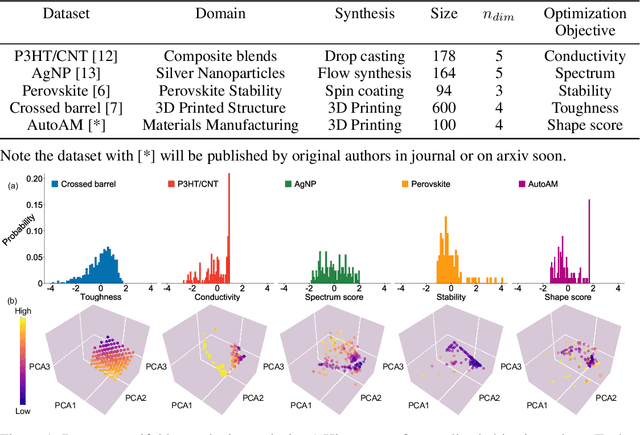
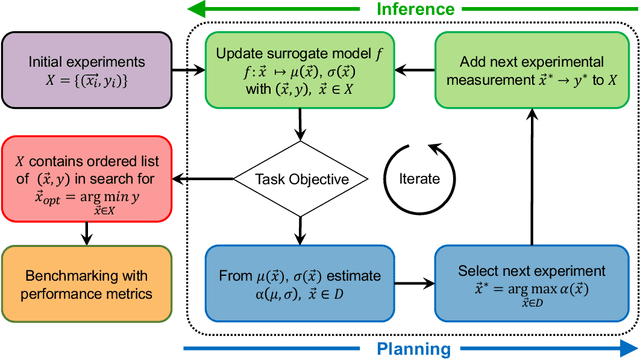
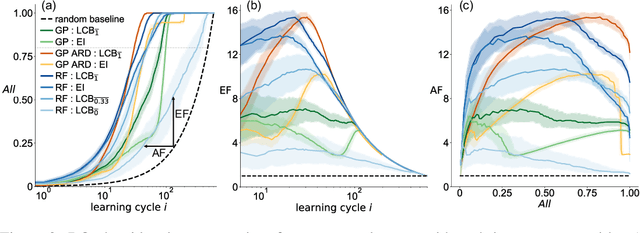
Abstract:In the field of machine learning (ML) for materials optimization, active learning algorithms, such as Bayesian Optimization (BO), have been leveraged for guiding autonomous and high-throughput experimentation systems. However, very few studies have evaluated the efficiency of BO as a general optimization algorithm across a broad range of experimental materials science domains. In this work, we evaluate the performance of BO algorithms with a collection of surrogate model and acquisition function pairs across five diverse experimental materials systems, namely carbon nanotube polymer blends, silver nanoparticles, lead-halide perovskites, as well as additively manufactured polymer structures and shapes. By defining acceleration and enhancement metrics for general materials optimization objectives, we find that for surrogate model selection, Gaussian Process (GP) with anisotropic kernels (automatic relevance detection, ARD) and Random Forests (RF) have comparable performance and both outperform the commonly used GP without ARD. We discuss the implicit distributional assumptions of RF and GP, and the benefits of using GP with anisotropic kernels in detail. We provide practical insights for experimentalists on surrogate model selection of BO during materials optimization campaigns.
Inverse design of crystals using generalized invertible crystallographic representation
May 15, 2020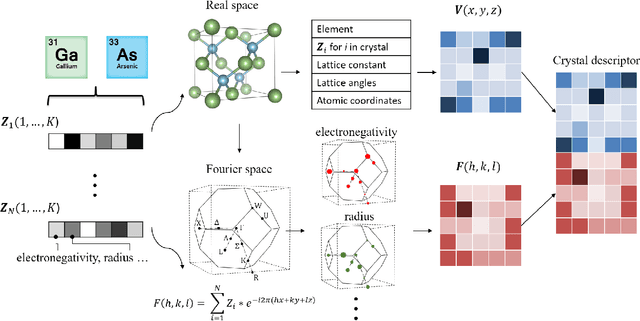


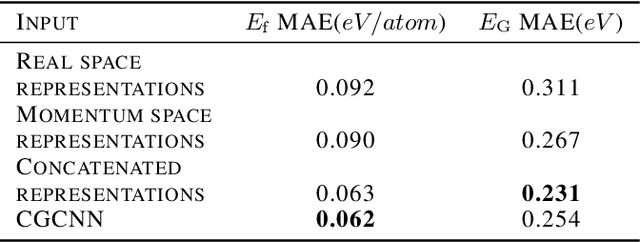
Abstract:Deep learning has fostered many novel applications in materials informatics. However, the inverse design of inorganic crystals, $\textit{i.e.}$ generating new crystal structure with targeted properties, remains a grand challenge. An important ingredient for such generative models is an invertible representation that accesses the full periodic table. This is challenging due to limited data availability and the complexity of 3D periodic crystal structures. In this paper, we present a generalized invertible representation that encodes the crystallographic information into the descriptors in both real space and reciprocal space. Combining with a generative variational autoencoder (VAE), a wide range of crystallographic structures and chemistries with desired properties can be inverse-designed. We show that our VAE model predicts novel crystal structures that do not exist in the training and test database (Materials Project) with targeted formation energies and band gaps. We validate those predicted crystals by first-principles calculations. Finally, to design solids with practical applications, we address the sparse label problem by building a semi-supervised VAE and demonstrate its successful prediction of unique thermoelectric materials
Graph Convolutional Neural Networks for Polymers Property Prediction
Nov 15, 2018
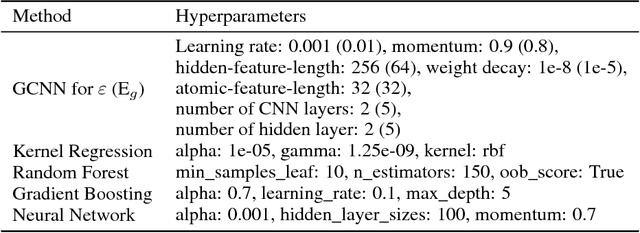


Abstract:A fast and accurate predictive tool for polymer properties is demanding and will pave the way to iterative inverse design. In this work, we apply graph convolutional neural networks (GCNN) to predict the dielectric constant and energy bandgap of polymers. Using density functional theory (DFT) calculated properties as the ground truth, GCNN can achieve remarkable agreement with DFT results. Moreover, we show that GCNN outperforms other machine learning algorithms. Our work proves that GCNN relies only on morphological data of polymers and removes the requirement for complicated hand-crafted descriptors, while still offering accuracy in fast predictions.
Predicting thermoelectric properties from crystal graphs and material descriptors - first application for functional materials
Nov 15, 2018
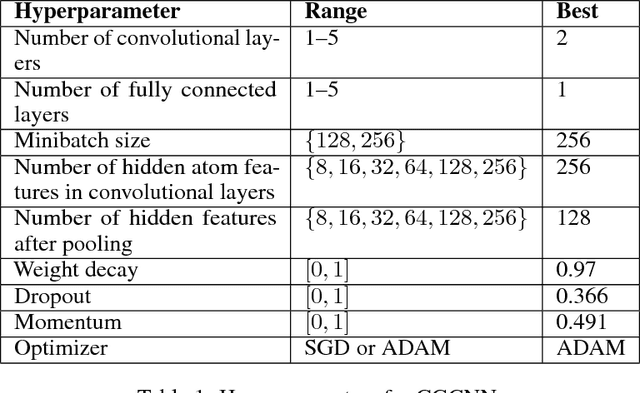

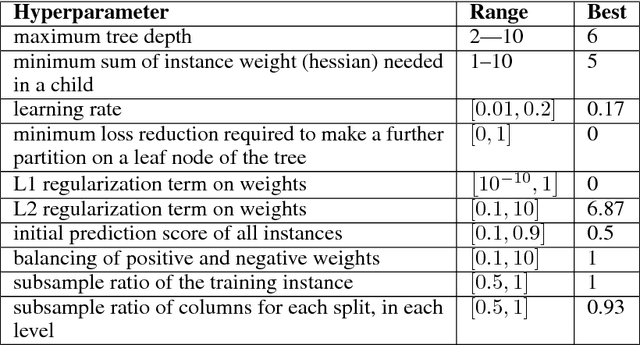
Abstract:We introduce the use of Crystal Graph Convolutional Neural Networks (CGCNN), Fully Connected Neural Networks (FCNN) and XGBoost to predict thermoelectric properties. The dataset for the CGCNN is independent of Density Functional Theory (DFT) and only relies on the crystal and atomic information, while that for the FCNN is based on a rich attribute list mined from Materialsproject.org. The results show that the optimized FCNN is three layer deep and is able to predict the scattering-time independent thermoelectric powerfactor much better than the CGCNN (or XGBoost), suggesting that bonding and density of states descriptors informed from materials science knowledge obtained partially from DFT are vital to predict functional properties.
 Add to Chrome
Add to Chrome Add to Firefox
Add to Firefox Add to Edge
Add to Edge